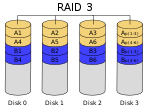That's what my research turned up, but that still doesn't make sense to me - think I'm missing a vital step here - surely the fact that the whole block has to wait for the parity bit to write doesn't matter, as you only need one parity bit per byte (on the 9 disk array scenario) So yes, it will only write as fast as the 9th disk, but it's writing to all 8 others in that time, so if the parity disk can write at 70MB/s, the whole array can then write at 8x70MB/s?
I can't quite grasp why distributing the parity bit makes any difference, surely each block will always be limited to the speed of the elected parity disk for that write, be it always one, or shared amongst them?
Nice pics from Wiki:
Raid 3
Raid 5
If the diagrams are correct, then in Raid 3 and Raid 5 each block will write at the speed of the Parity drive (in the Raid 5 case, the 1st block is limited by drive 4, 2nd block by drive 3 and so on). (eg 70MB/s) how does changing that drive alter the speed?
I always thought that the big difference was that Raid 3 split the data down to bit level and distributed it across the drives, where the other Raid levels worked on a minimum block size (32kb-128kb) - hence with smaller writes you lost performance, and have to tailor your block size to your task?



